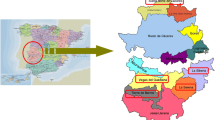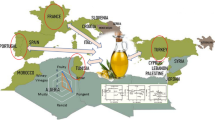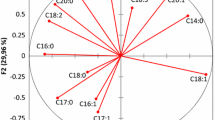Abstract
In this study, the fatty acid compositions of Turkish virgin olive oils produced in the Izmir province, an important olive production region of Turkey, were classified by chemometric methods: principal component analysis (PCA) and discriminant analysis (DA). A total of 103 oil samples were examined over the course of two harvest years (2001–2002 and 2002–2003). The samples were divided into five groups according to olive growing zones: North (Ayvalik cultivar), East (Memeli, Memecik, Domat and Gemlik cultivars), South (Memecik cultivar), Izmir Penisula (Erkence cultivar) and Firms (poly-varietial oils or commercial blends). Consistent with discriminant analysis (DA), the predicted grouping in terms of the two harvest years were correctly separated as 84.6 and 85.9%, respectively. The highest levels of predicted grouping for the two harvest years were found in the North (Ayvalik cultivar) and Izmir peninsula (Erkence cultivar) groups (as 100%). In addition to oleic, linoleic, linolenic, margaric and margoleic acids, total trans isomers of linoleic, linolenic and palmitic/linoleic were determined to be the best descriptive components for the oil samples.






Similar content being viewed by others
References
Boskou D (1996) Olive oil chemistry and technology. AOCS Press, Champaign, Illinois
Kiritsakis AK (1998) Olive Oil: from the tree to the table. Food & Nutrition Press Inc, Trumbull
http://www.tpi.org.tr. Accessed 28 Oct 2009
Aparicio R (1999) Characterization: mathematical procedures for chemical analysis. In: Aparicio R, Harwood J (eds) Handbook of olive oil: analysis and properties. pp 285–354. Springer-Verlag, New York
Gürdeniz G, Ozen B, Tokatli F (2008) Classification of Turkish olive oils with respect to cultivar, geographic origin and harvest year, using fatty acid profile and mid-IR spectroscopy. Eur Food Res Tech 227:1275–1281
Andjelkovic M, Acun S, Van Hoed VV, Verhé R, Van Camp J (2008) Chemical composition of Turkish olive oil: Ayvalik. J Am Oil Chem Soc 85:135–140
Kiralan M, Bayrak A, Ozkaya MT (2009) Oxidation stability of virgin olive oils from some important cultivars in East Mediterranean area in Turkey. J Am Oil Chem Soc 86:247–252
Dıraman H, Dibeklioğlu H (2009) Characterization of Turkish virgin olive oils produced from early harvest olives. J of Am Oil Chem Soc 86:663–674
Salvador MD, Aranda F, Gomez-Alonso S, Fregapane G (2003) Influence of extraction system, production year and area on Cornicabra virgin olive oil: a study of five crop seasons. Food Chem 80:359–366
Casas JS, Bueno EO, Garcia AMM, Cano MM (2003) Estudio del contenido en acidos grasos de aceites monovarietales elaborades a partir de aceitunas producidas en la region extremeňa. Grasas Aceites 54:371–377
Škevin D, Rade D, Strucelj D, Mokrovcak Z, Nederal S, Bencic D (2003) The influence of variety and harvest time on the bitterness and phenolic compounds of olive oil. Eur J Lipid Sci Tech 105:536–541
Dugo Mo G, Alfa M, La Pera L, Mavrogeni E, Pallicino D, Pizzimenti G, Maisano R (2004) Characterization of Sicilian virgin olive oils, note X: a comparasion between Cerasuola and Nocellera del Bellice varieties. Grasas Aceites 55:415–422
Aranda F, Gomez–Alanso S, Rivera del Alamo RM, Salvador MD, Fregapane G (2004) Triglyceride. total and 2n- position fatty acid composition of Cornicobra virgin olive oil: comparision with other Spanish cultivars. Food Chem 86:485–492
Natale L, Bono S (2006) Characteristics of the olive oils of Lazio. Olivae 106:32–41
Dunteman GH (1989) Principal component analysis. Lage, Beverly Hills
Tsimidiou M, Karakostas KX (1993) Geographical classification of Greek virgin olive oil by non-parametric multivariate evaluation of fatty acid composition. J Sci Food Agric 62:253–257
Lanza CM, Russo C, Tomaselli F (1998) Relationship between geographical origin and fatty acid composition of extra-virgin olive oils produced in three areas of Eastern Sicily. Italian J Food Sci 10:359–366
Stefanoudaki E, Kotsikafi F, Koutsafakis A (1999) Classification of virgin olive oils of the two major Cretan Cultivars based on their fatty acid composition. J Am Oil Chem Soc 76:623–626
Lanteri S, Armanino C, Peri E, Palapoli A (2002) Study of oils from Calabrian olive cultivars by chemometric methods. Food Chem 76:501–507
Motilva JM, Ramo T, Romero MP (2001) Caracterization geográfica de los aceites de oliva virgines de la denominacion de origen protegida ‘Les Garrigues’ por sul perfil de acidos grasos. Grasas Aceites 52:26–32
Ollivier D, Artaud J, Pinatel C, Durbec JP, Guèrère M (2003) Triacylglycerol and fatty acid compositions of French virgin olive oils. Characterization by chemometrics. J Agric Food Chem 51:5723–5731
http://www.unctad.org/infocomm/anglais/olive/market.htm#prod. Accessed 28 Oct 2009
Canözer Ö (1991) The catalogue for standard olive varieties. Republic of Turkey, Ministry of Agriculture and Rural Affairs. TUGEM Publication General No: 334, series:16. Ankara
Olive Research Institute (2006) Department of Economy and Statistical (Unpublished Data)
Anonymous (1987) Standard methods for analysis of oils, fats and derivates, International Union of Pure and Applied Chemistry, 7th edn. Blackwell (IUPAC Method 2.301)
Anonymous (1996) Determination of trans unsaturated fatty acids by capillary column gas chromatography. COI/T.20.Doc.no:17. 6 June 1996. Madrid
Diraman H, HişilY (2004) The research on the determination of trans fatty acids in olive oils produced from different systems in Aegean region. Project number: TAGEM/GY/00/14/041. Issue:123. Olive Research Institute, Bornova, p 96
SPSS (2001) Base 12.0 Applications Guide. SPSS Inc., Chicago
International Olive Oil Council (2008) Trade standard applying to olive oils and olive: pomace oils. COI/T.15.NC No 3/Rev. 1, 2003. http://www.internationaloliveoil.org. Accessed 15 Oct 2009
Anonymous (2007) Turkish Food Codex Communique on Olive oil and Pomace oil. The Official Gazette of Republic of Turkey (Dated 03.08.2007, Number: 26602) Ankara
Mousa MY, Gerasopoulos D, Metzidakis I, Kiritakis A (1996) Effect of altitude on fruit and oil quality characteristics of Mastoides Olives. J Sci Food Agric 71:345–350
Jackson JE (1991) A user’s guide to principal components. John, New York
Jollife IT (1972) Discarding variables in a principal component analysis, I: artificial data. Appl Stat 21:160
Jollife IT (1972) Discarding variables in a principal component analysis, I: real data. Appl Stat 22:21
Acknowledgments
The authors are grateful to Mr. Metin Aydogdu (Agric. Eng. Department of Geographical Information Systems, Ministry Agriculture and Rural Affairs, Ankara) for the map of Izmir Province.
Author information
Authors and Affiliations
Corresponding author
About this article
Cite this article
Diraman, H., Saygi, H. & Hisil, Y. Relationship Between Geographical Origin and Fatty Acid Composition of Turkish Virgin Olive Oils for Two Harvest Years. J Am Oil Chem Soc 87, 781–789 (2010). https://doi.org/10.1007/s11746-010-1557-2
Received:
Revised:
Accepted:
Published:
Issue Date:
DOI: https://doi.org/10.1007/s11746-010-1557-2




